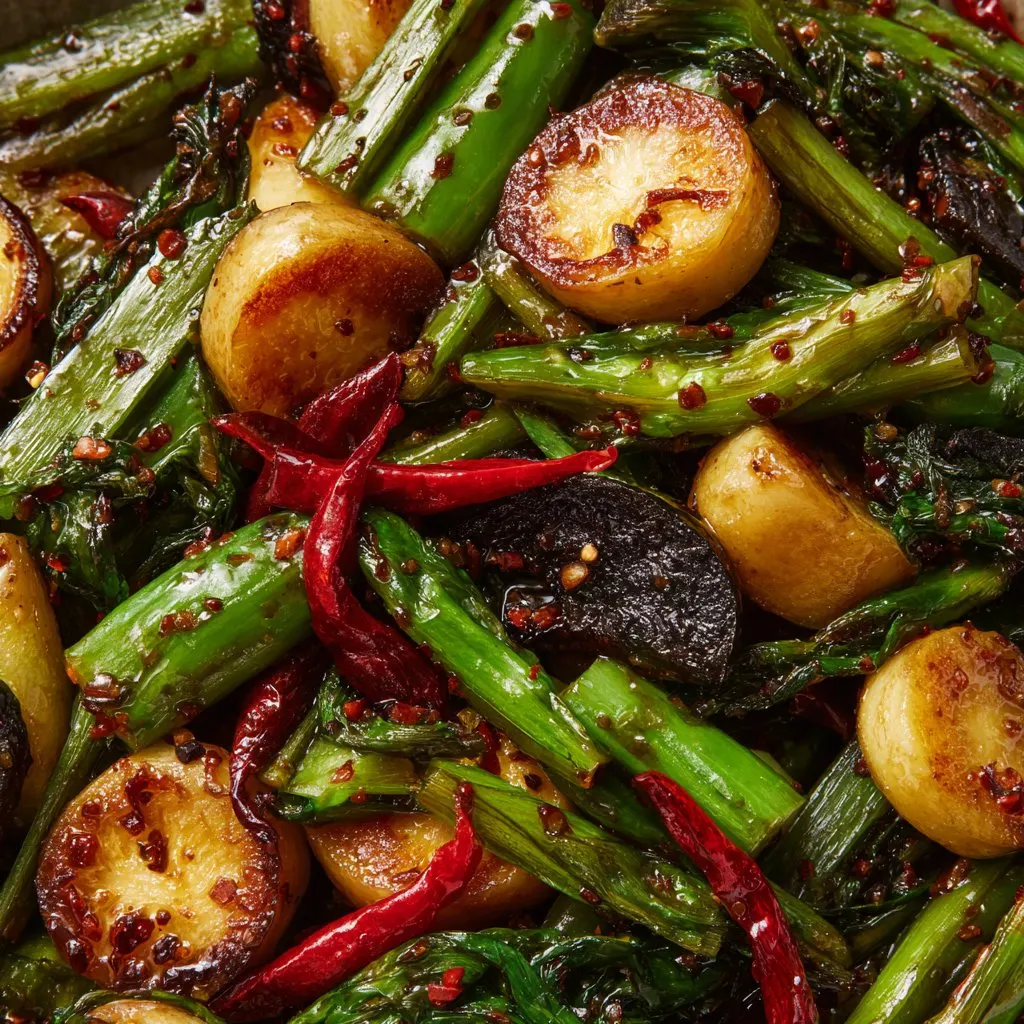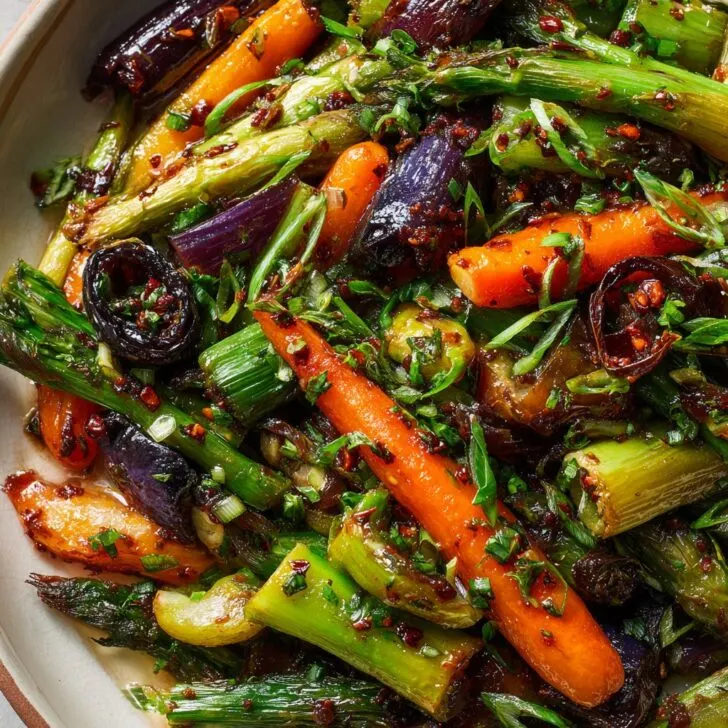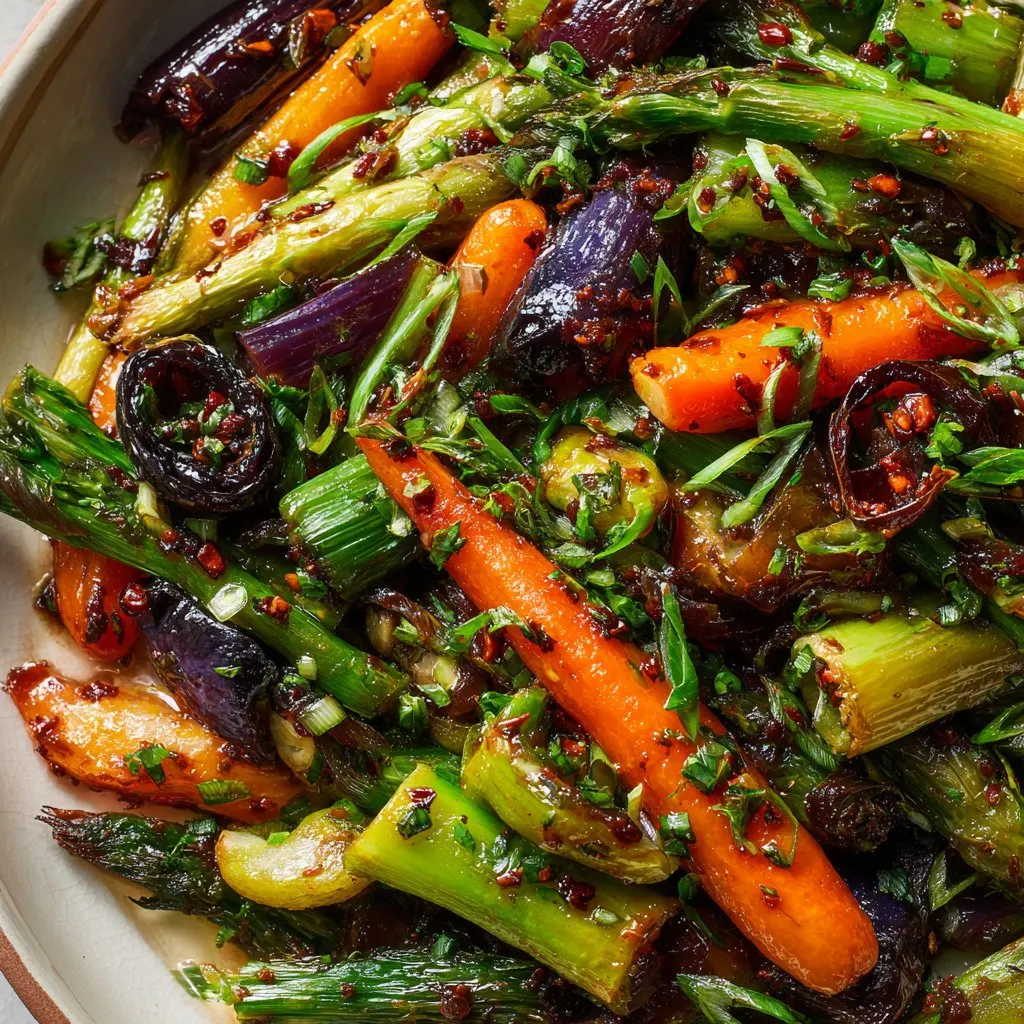Alright, Why Am I Obsessed With Blistered Vegetables?
I have this memory from last summer—standing at my stove, windows open, neighbors grilling next door, I'm hunched over a screaming-hot pan trying to get my green beans to that perfect, charred-but-not-burnt stage. (My smoke alarm disagreed, but we made it.) Anyway, that's when I realized: veggies get this wild flavor when you let them char a bit, not just sauté them to death. Add scallion oil? Well, that's the kicker—bold, bright, and a little fancy even if you're just in your socks. Plus, honestly, the color is almost too pretty.
Why You'll Love This—Or At Least Why I Keep Making It
I make this when I want something that's way more fun than a basic side but isn't, you know, a whole production. My family goes crazy for this (especially when I use extra scallion oil, which is basically good on anything—I've even drizzled it on pizza; no regrets). Sometimes, if I'm feeling lazy, I'll just eat this for dinner on its own with some rice and call it a day. Oh, and if you've ever gotten annoyed at veggies sticking to the pan? Me too. But I'll walk you through how to keep the cursing (mostly) to a minimum.
What You'll Need (and Some Swaps)
- 2-3 cups mixed vegetables (I like green beans, snap peas, and bell peppers—my cousin swears by zucchini, and honestly, it's fine in a pinch)
- 2 tablespoons neutral oil (I've used peanut oil, safflower, or even canola; my grandmother was obsessed with Wesson, but any will do)
- 1 teaspoon flaky salt (I use Maldon, but kosher salt is cool)
- Scallion Oil:
- 4-5 scallions, thinly sliced (green and white parts—sometimes I just use the green if my fridge is looking sad)
- ½ cup neutral oil (again, same drill as above)
- ½ teaspoon salt
- Optional: pinch of chili flakes, splash of sesame oil (I toss these in when I want a kick)
Let's Make This—Step by Step (And a Few Detours)
- Scallion Oil First: Put the sliced scallions in a heatproof bowl. Heat the oil in a small saucepan until it just starts to shimmer (don't let it smoke—I've done that; the smell lingers for ages). Pour the hot oil over the scallions; it should sizzle like crazy. Add salt and, if you're feeling bold, those chili flakes or a drop of sesame oil. Stir and set aside.
- Crank Up the Heat: Get your largest skillet (cast iron is my favorite, but nonstick works; I've even tried it in a wok which was...messy but fun). Heat the pan until it's properly hot. Like, you should be able to feel the heat when you hover your hand over it.
- Blister the Veg: Toss in the veggies and don't move them for a minute—seriously, resist the urge. They need this time to get those dark blisters. Then stir, let them sit again, repeat 3-5 minutes. (This is where I sneak a taste or two, just to make sure they're not burning... or maybe that's just an excuse.)
- Salt 'Em: Sprinkle with salt right when they come out. They should smell a little smoky and look all spotty.
- Drizzle and Serve: Pile the veggies onto a plate and spoon over that scallion oil. If you want extra oil, go for it—no one is judging.
(Side note: Once I accidentally added the scallion oil to the pan with the veggies still inside. The flavor was fine, but it lost the punchy freshness. So, yeah, wait until the end.)
Notes from My Trial-and-Error Kitchen
- If you crowd the pan, the veggies steam instead of blister. But, if you only have a small pan, just do it in batches (I learned this the hard way—twice).
- The scallion oil keeps in the fridge for a few days; the flavor mellows a bit and, I think, gets even better.
- Actually, you can use red onions for the oil if you run out of scallions; it’s a different vibe, but still tasty!
Variations I've Tried (For Better or Worse)
- Added thinly sliced carrots: surprisingly good, maybe a bit sweet.
- Used broccoli florets: they got a tad too crunchy for my taste, but my partner loved it.
- Eggplant: honestly, the texture went weird. Would not recommend unless you’re an eggplant superfan.
- Mixed in a splash of soy sauce at the end: omg, so savory, but go easy or it gets salty fast.
Equipment—And My Two Cents If You Don't Have It
- Larger skillet or wok (if you only have a small one, just do two batches—yeah, it's more dishes, but the flavor's worth it).
- Slotted spoon or spatula (I once used tongs, and it worked fine—so improvise if you must!)
- Heatproof bowl for the scallion oil (in a pinch, I used a Pyrex measuring cup; just be careful, hot oil is no joke)

How to Store (Not That It'll Stick Around)
If you do have leftovers, pop them in an airtight container in the fridge. They'll keep for about two days, though honestly, in my house it never lasts that long—I usually find myself picking at them cold with a fork. I think this actually tastes better the next day, but don't tell my family or they'll beat me to it.
Serving Ideas—And Our Weird Family Tradition
Usually, I serve this as a side with steamed rice and whatever protein is hanging around, but sometimes we pile it on top of noodles and add a soft-boiled egg (don’t skip the egg, trust me). My aunt once served it with grilled chicken and a big glass of lemonade; something about that combo just works.
Pro Tips (a.k.a. Lessons from My Kitchen Fails)
- Don't rush the pan heating. I once tried to speed things up, tossed the veggies in early, and got mush instead of blistered. Not worth it.
- If the oil starts smoking, just pull the pan off the heat for a minute—it recovers, promise.
- And for the love of all things tast, taste as you go. The difference between blistered and burnt is like two seconds (no pressure!).
FAQ—Real Questions I've Been Asked
- Can I use frozen veggies?
Sort of? They won’t blister the same way, but if you pat them dry first and don’t crowd the pan, it’ll get close enough. Not exactly the same, but hey, sometimes you gotta work with what you’ve got. - Is scallion oil spicy?
Nah, not unless you add chili flakes. If you want heat, go wild. If not, leave 'em out. - Do I need a cast iron skillet?
Nope! I think it works better, but any heavy pan will do. Nonstick is fine (just don’t try to get it to full blast; it’ll warp—I learned that the hard way). - Can I use garlic in the scallion oil?
Sure, but keep an eye on it—garlic burns fast. Maybe add it after the oil cools a bit. Or just skip it if you’re in a rush. - Where do you get your scallion oil inspiration?
Honestly, I first saw it on Serious Eats, then just started riffing. And Bon Appétit has a version that's pretty cool too.
Okay, that’s the gist. Now, I know this turned into a bit of a ramble (I did tell you about my neighbor’s grill, right?), but honestly, cooking is all about those little stories and tweaks. If you try it, let me know how it goes—or if you make a wild substitution that actually works. Happy blistering!
Ingredients
- 1 cup snap peas, trimmed
- 1 cup baby bell peppers, halved
- 1 cup zucchini, sliced
- 1 cup cherry tomatoes
- 2 tablespoons vegetable oil
- ½ teaspoon kosher salt
- ¼ teaspoon black pepper
- 4 scallions, thinly sliced
- 2 tablespoons sesame oil
- 1 teaspoon soy sauce
- 1 teaspoon rice vinegar
Instructions
-
1Heat a large skillet or wok over high heat. Add vegetable oil and swirl to coat.
-
2Add snap peas, baby bell peppers, zucchini, and cherry tomatoes to the pan. Season with salt and black pepper.
-
3Cook the vegetables, stirring occasionally, until blistered and slightly charred, about 8-10 minutes.
-
4Meanwhile, in a small saucepan, heat sesame oil over medium heat. Add scallions and cook until fragrant and just softened, about 2 minutes.
-
5Remove the scallion oil from heat and stir in soy sauce and rice vinegar.
-
6Transfer blistered vegetables to a serving platter and drizzle with the warm scallion oil. Serve immediately.
Approximate Information for One Serving
Nutrition Disclaimers
Number of total servings shown is approximate. Actual number of servings will depend on your preferred portion sizes.
Nutritional values shown are general guidelines and reflect information for 1 serving using the ingredients listed, not including any optional ingredients. Actual macros may vary slightly depending on specific brands and types of ingredients used.
To determine the weight of one serving, prepare the recipe as instructed. Weigh the finished recipe, then divide the weight of the finished recipe (not including the weight of the container the food is in) by the desired number of servings. Result will be the weight of one serving.
Did you make this recipe?
Please consider Pinning it!!


